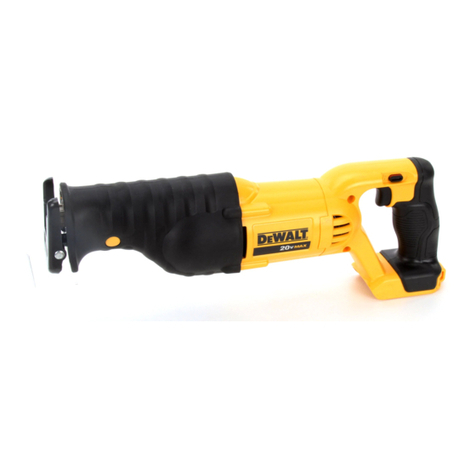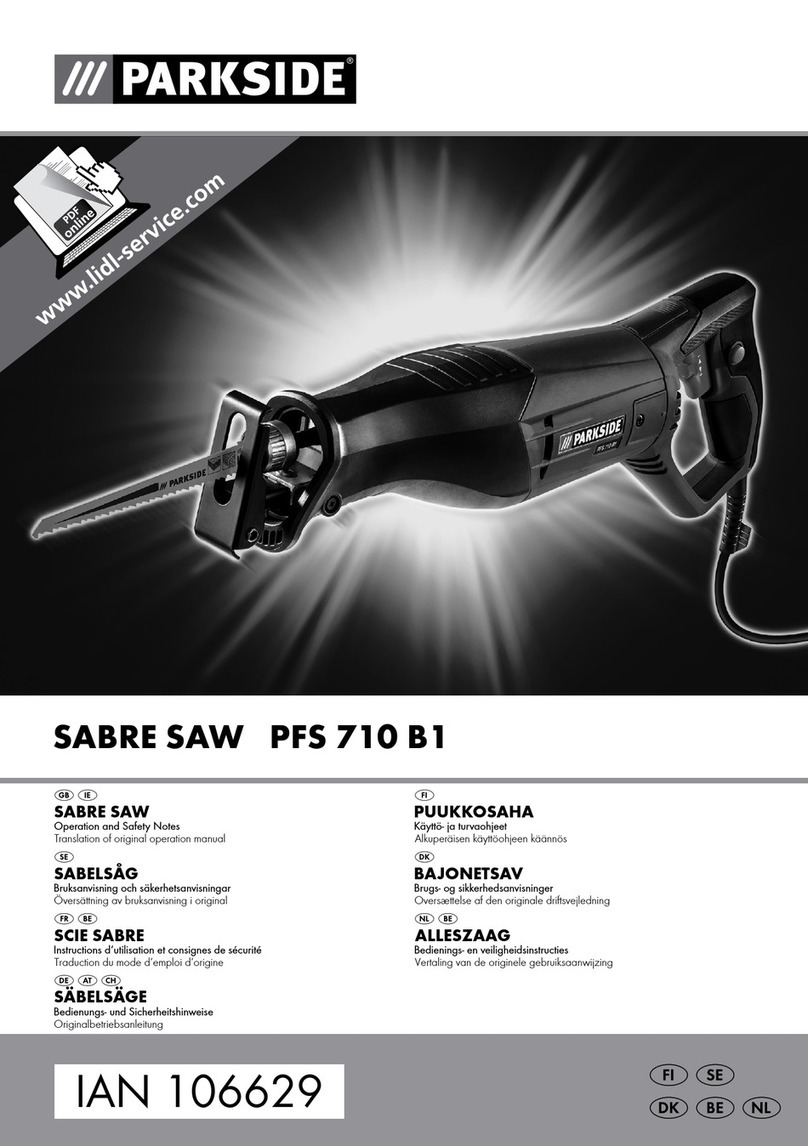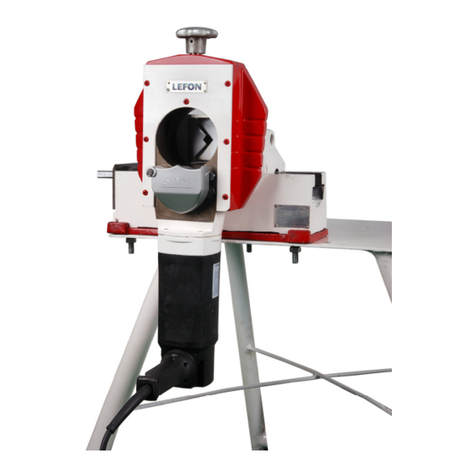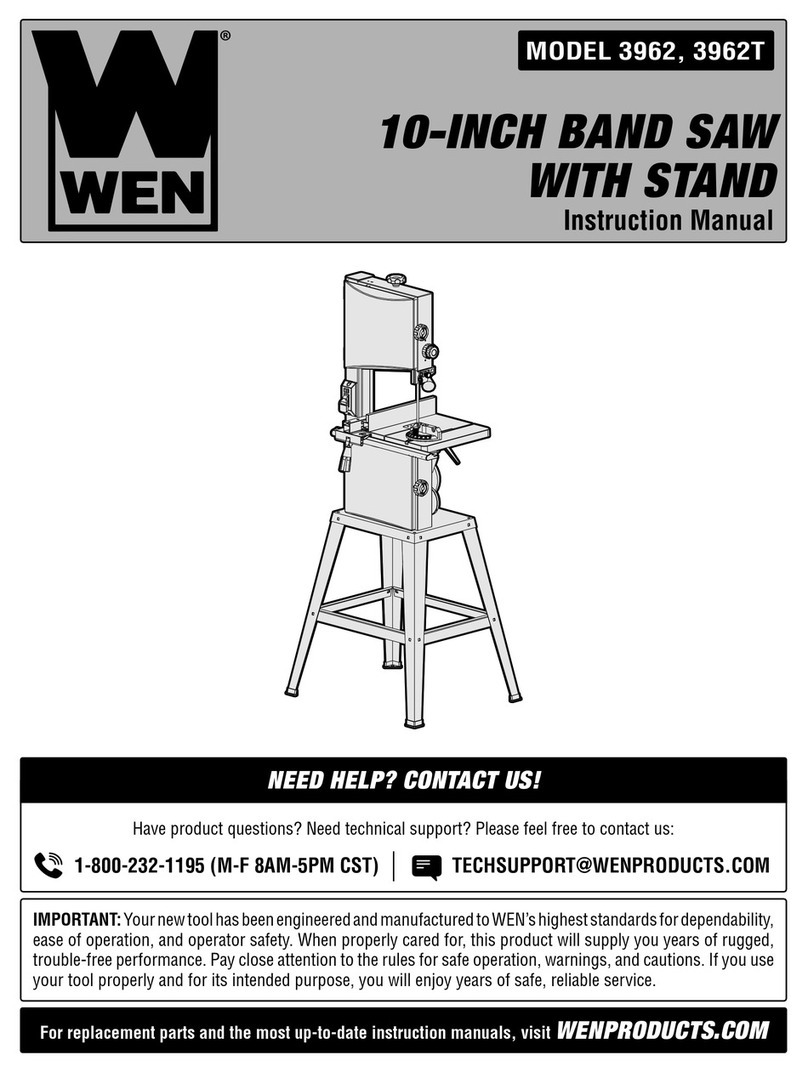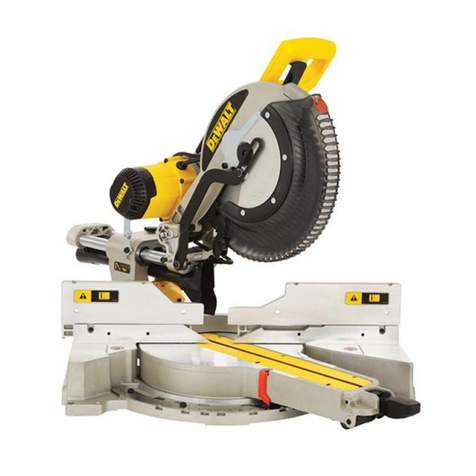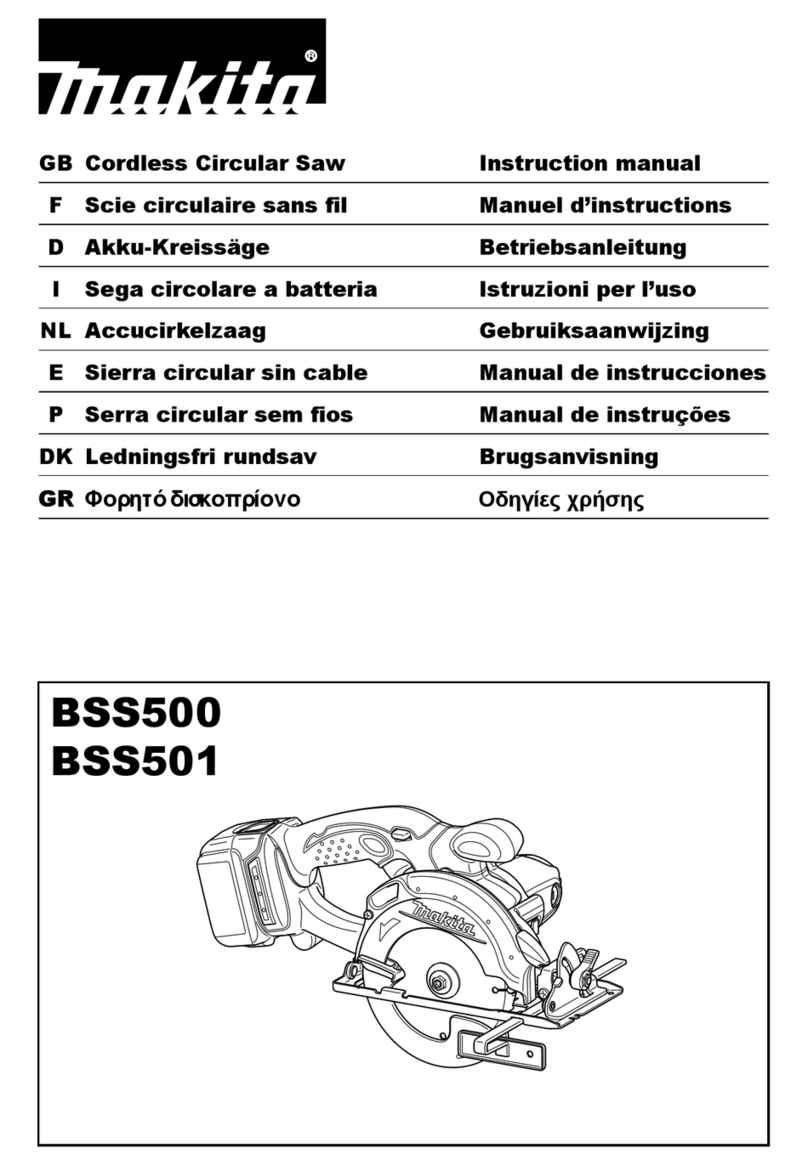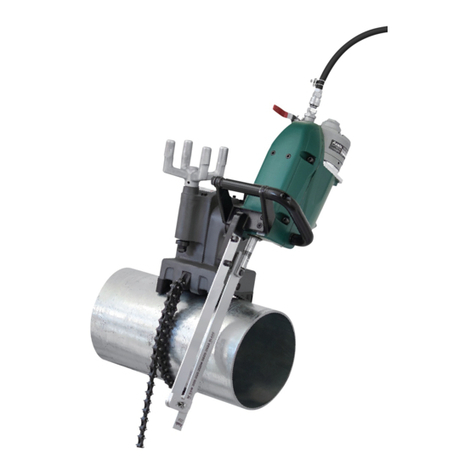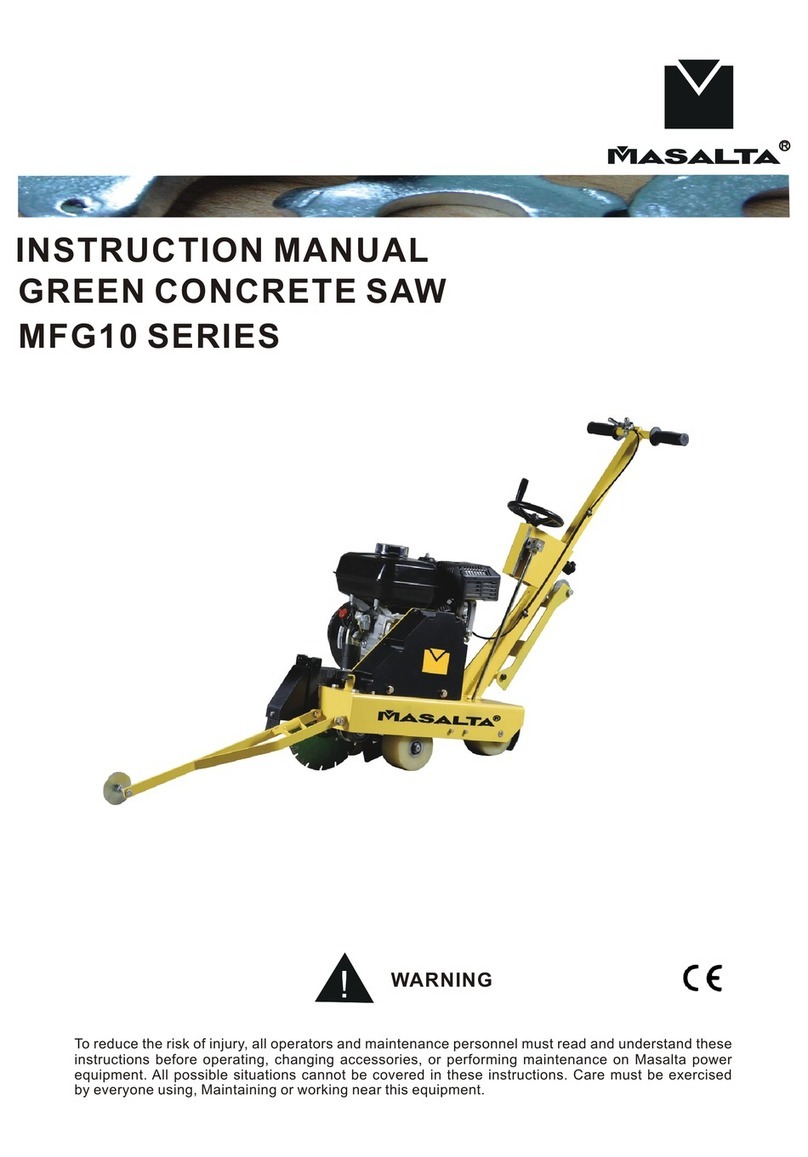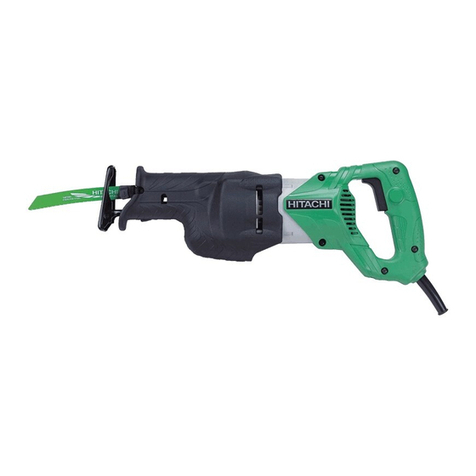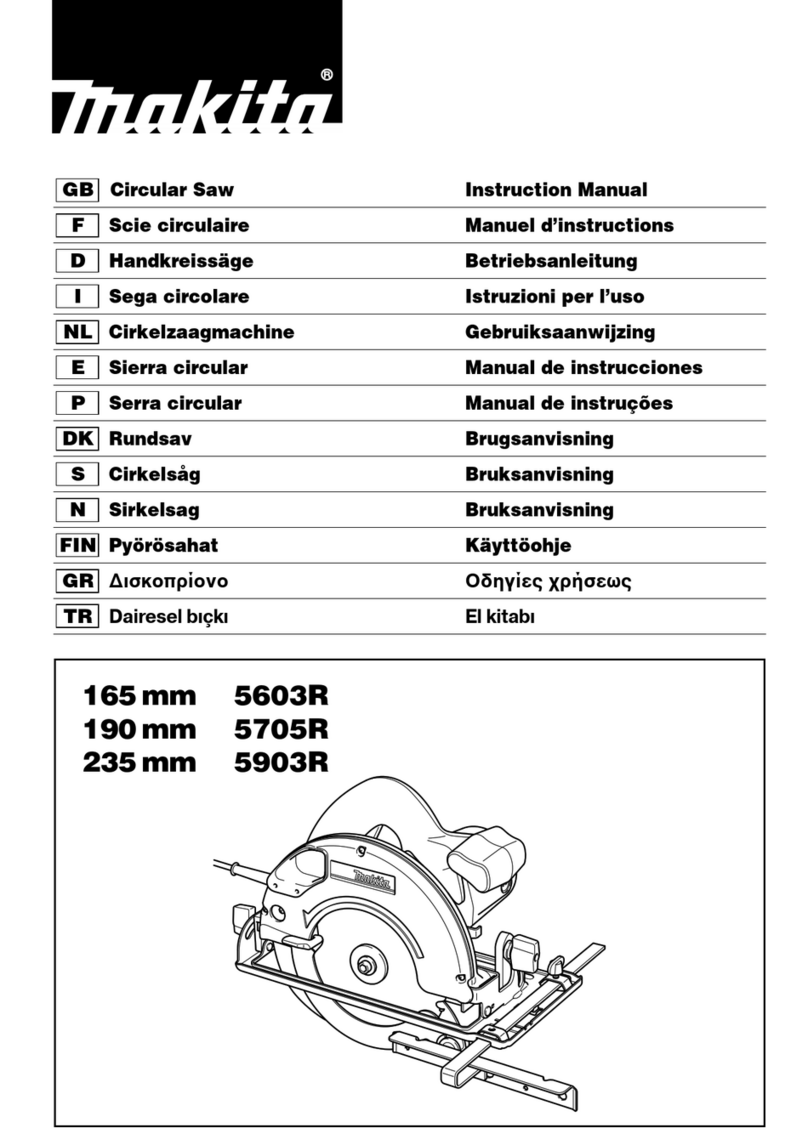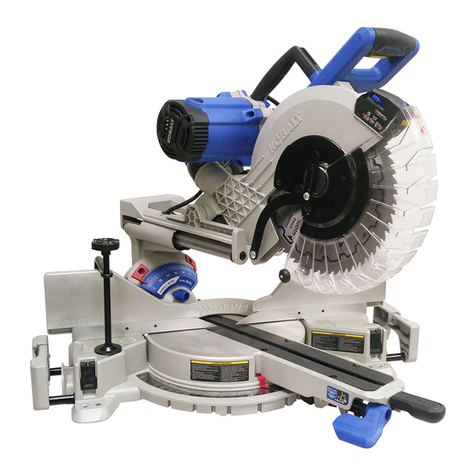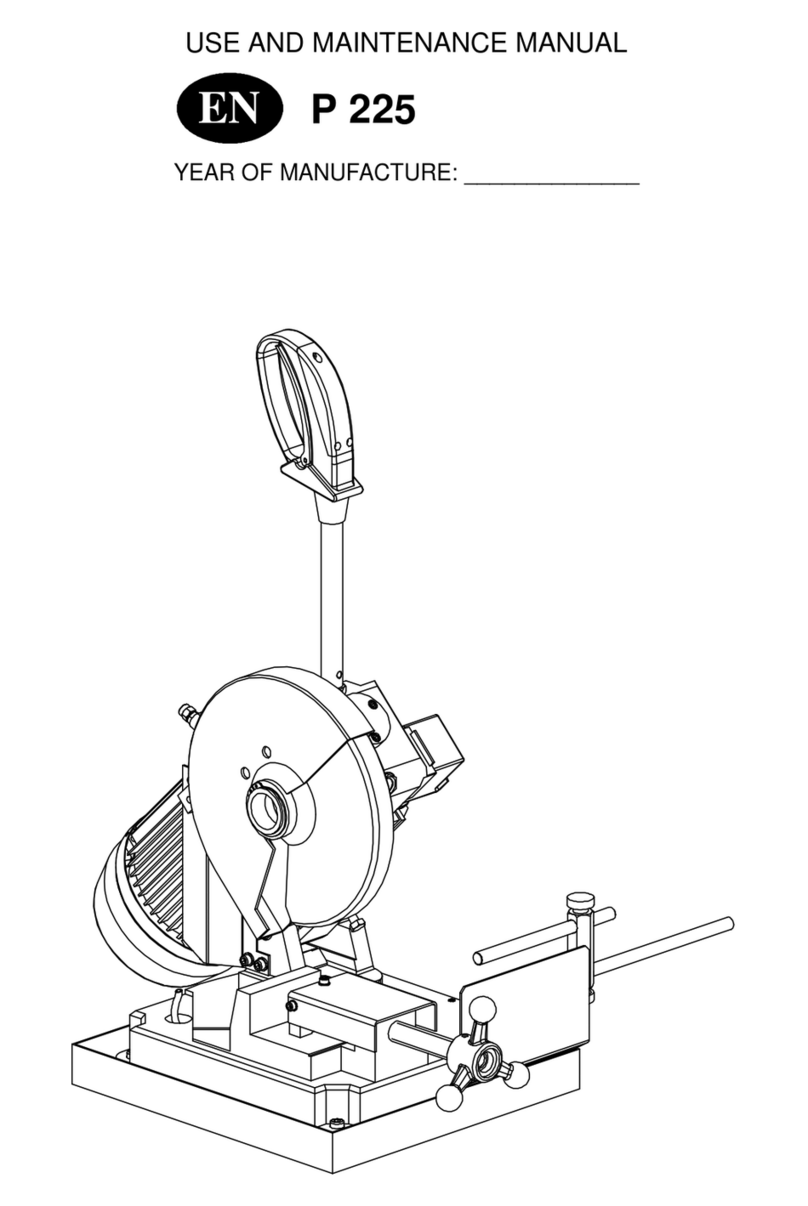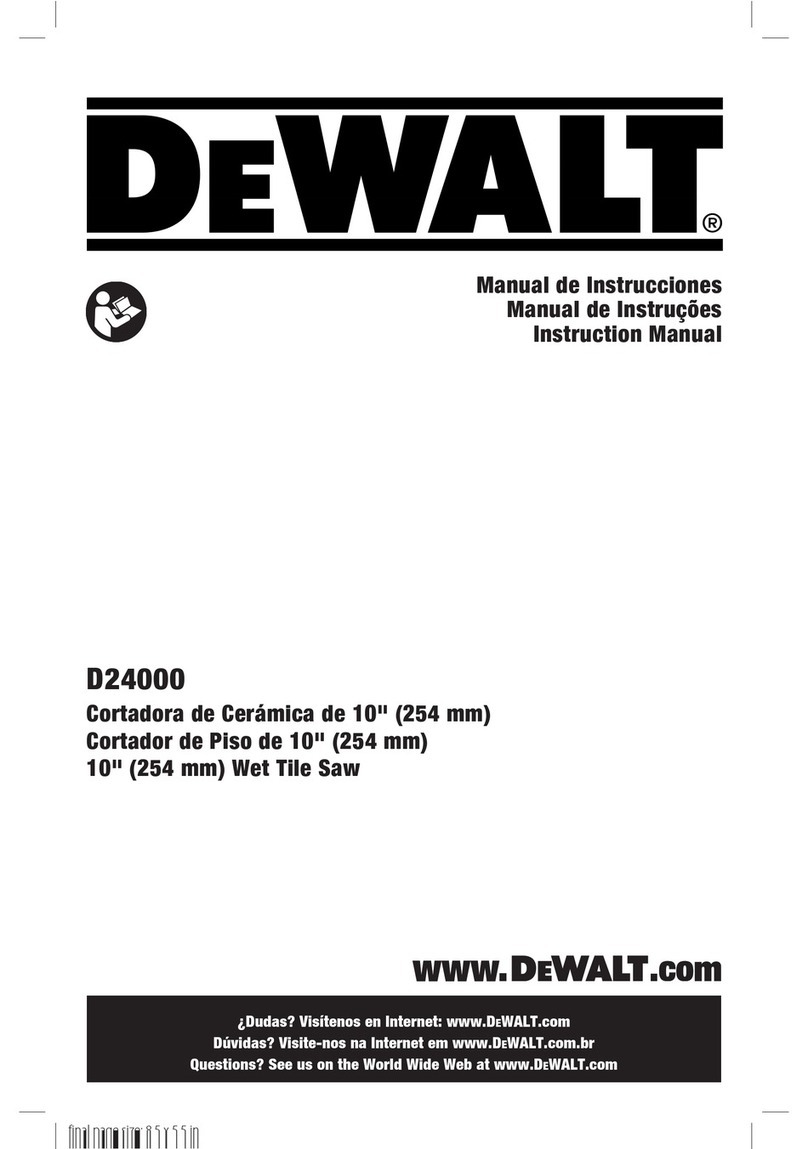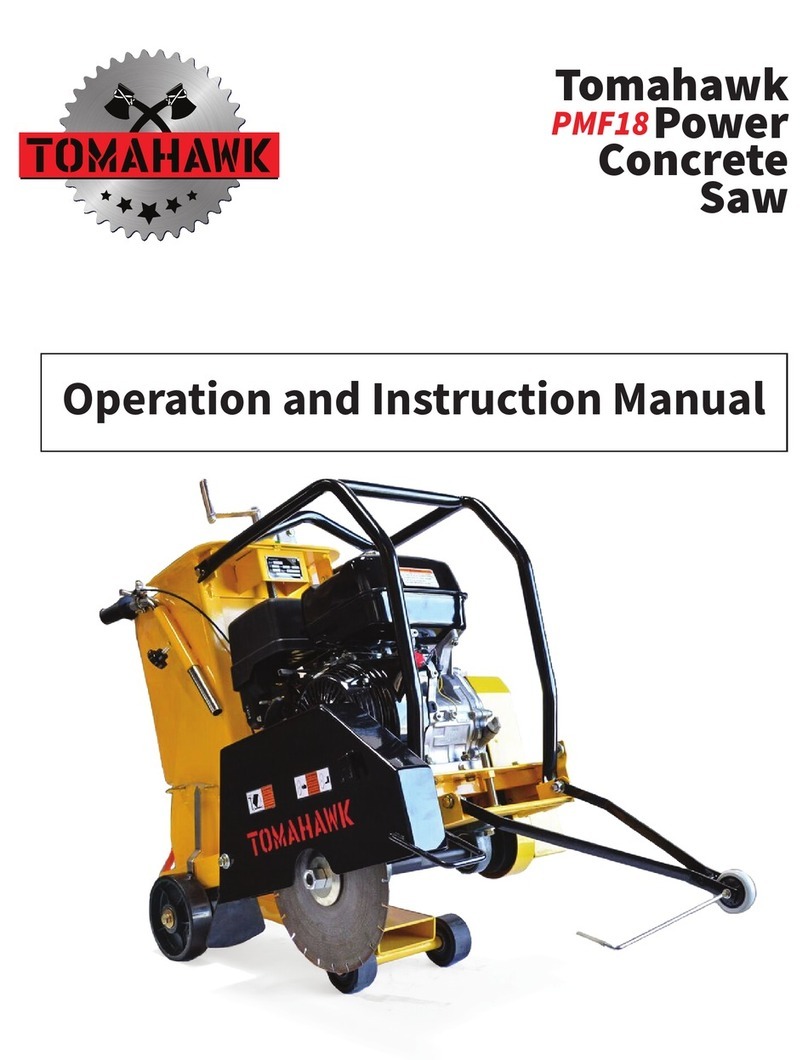Blucave TRS-600-1 User manual

1
5
2
6
3
7
4
8
ASSEMBLY:
Caution: All assembling, mounting, disassembling
and removing should be done with the saw turned off.
Remove the power cord from the power supply.
TOOLBOD & CONTROLLER
Caution: BluCave offer both AC (powered) and DC
(cordless) operated Controllers and ToolBods.
AC ToolBods will only operate with an AC Controller
and DC ToolBods will only operate with a DC Controller.
For simple identification look for the appropriate
colour marking with green representing AC and orange
representing DC.
ASSEMBLING:
Align the fixed hook (Grey)
of the Controller into the
corresponding recess on the
underside of the ToolBod.
Once located and engaged,
close the two faces of the
Controller and ToolBod
together until they click into place. (It’s as easy as
Hook, Swing and Click) See Fig. 1.
DISASSEMBLING:
Ensure the Reciprocating Saw is switched off before
trying to remove the Controller. Press the unlock symbol
located on the Controller and then turn the ToolBod
away from the Controller.
FITTING SAW BLADES
Ensure the blade is not damaged and always clean the
shank thoroughly before fitting.
Ensure the saw is switched off and unplugged.
Rotate the blade holder anti-clockwise to unlock
and insert the blade with the sharp side facing the
underside of the ToolBod. See fig. 2. Ensure the small
hole on the end of the blade
is aligned in the blade holder
so the holding pin will pass
through it when the blade
holder is released.
Slowly release the blade
holder and ensure the blade
is firmly held in place.
Always test under no load
to ensure the blade is fitted
correctly before use.
To remove the blade rotate
the blade holder anti-
clockwise until the holding
pin releases it.
CAUTION: The blade may be
hot to touch after use.
Note: Always clean the blades before storing.
ADJUSTING THE SHOE
The pivoting shoe is designed to sit flush against the
work piece. It provides a guide for stability and can be
set at a variety of distances to limit the depth of a cut.
It can also be positioned to limit the use of any parts of
the blade that may have lost cutting efficiency. Pull the
shoe plate adjustment lever down to release the lock.
See fig. 3. Adjust shoe position. See fig. 4. Then return
lever to locked position. See fig. 5.
OPERATION:
Caution: Check that the voltage of your power supply
matches the specified voltage on the ToolBod and on
the Controller. If the voltages of either the Toolbod or
Controller do not match the power supply voltage do not
use the unmatched item/s.
Caution: Always ensure the cord guard is extended and
the tool is not used with it in the `storage’ position. See
AC Controller instructions for details.
Note: Always wear a dust mask as harmful dust may be
generated while working.
SWITCHING ON/OFF
Ensure the Controller and ToolBod are correctly
connected and the saw blade is securely in place
before operating. Plug the power cord into the power
supply (and switch it on if it’s switchable). The blue
power indicator on the Controller will illuminate once
connected to the power supply.
Squeeze the trigger to start the Reciprocating Saw.
Keep the trigger depressed to keep the saw operating.
Release the trigger to stop the saw.
To provide stable speed the power can be locked-on
by pressing the lock button on the Controller when the
trigger is completely depressed.
Squeeze the trigger fully to release the lock-on feature
then release the trigger to stop the saw.
SPEED
The Reciprocating Saw is a variable speed ToolBod.
As you squeeze the trigger on your Controller the
speed will vary from slowest to fastest at maximum
depression. The trigger also has a variable speed dial
which may be pre-selected before switching on.
Turn the dial to `A’ for the lowest speed or up to `E’ for
the highest speed.
Low speed is ideal for delicate materials when minimum
power and greater control is required.
Medium speed is suitable when a balance of power and
control is needed.
High speed produces fast cutting when accuracy is not
critical.
STORAGE:
ToolBods come with their own unique storage dock for
compact and protective housing inside the BluCave
Carry Cabinets See Fig. 6
Warning: Reciprocating Saw
storage dock will only fit in
the lowest slot of a Carry
Cabinet.
WELCOME:
CONGRATULATIONS
YOU’RE NOW A
BLUCAVER!
You’re one of the growing community who have
embraced the BluCave work zone!
The BluCave Reciprocating Saw is one of the many
convenient AC ToolBods (power tool bodies) that
clicks into your BluCave AC Controller.
REMEMBER:
Comply with all safety precautions and
instructions when using your BluCave products.
• When in doubt always ask for advice.
• Always wear protective clothing.
• Always work in an uncluttered environment.
TIPS:
When cutting metal objects such as pipes, steel
rods, aluminum, brass, copper and sheet metal
always spread a thin film of oil over the cutting
surface.
Press the pivoting shoe firmly against the work
piece and do not allow the saw to bounce.
ENJOY:
Need some inspiration or support? The BluCave
website opens-up a whole new world of DIY.
You can ask for help, gain real time product
information, share ideas and receive regular
updates on special BluCave offers.
ACCESSORIES: A set of accessories is available as a
starter kit for each BluCave ToolBod.
VERSATILE CARRY CABINETS: The BluCave Carry
Cabinets provide storage options for the complete
BluCave range and even your existing tools.
They can be used as full sized portable cases or
mounted on the BluCave Rail as stylish cabinets.
BOOSTERS: You can even ‘boost’ your BluCave to
include power, light and audio.
Visit BluCave.com to view the complete work zone.
DID YOU KNOW…
The Reciprocating Saw can be used for cutting into
timber frame walls, plaster and copper pipes. (Always
ensure services are turned off and you know what is
inside the wall before cutting into it)
SYMBOL:
W Watts
V Volts
A Amps
Hz Hertz
~ Alternating Current
Kg Kilograms
mm Millimetres
n0 No load speed
min-1 Revolutions or reciprocations per minute
dB(A) Decibels (A Weighted)
m/s² Vibration
ahAverage vibration
K Uncertainty
Double Insulated Construction
GETTING TO KNOW YOUR
BLUCAVE POWER TOOL:
RECIPROCATING SAW
ORIGINAL INSTRUCTIONS
MODEL NO: TRS-600-1
2
5
4
3
1
67
10
8
9
CONTROLLER (sold seperately)
1. Live Tool Indicator
2. Cord Guard
3. Lock Button
4. Trigger
5. Variable Speed Dial
6. Controller Unlock Button
Assembly.....................................................................
ToolBod and Controller...............................................
Fitting Saw Blades......................................................
Adjusting the Shoe.....................................................
Operation....................................................................
Switching On/Off........................................................
Speed...........................................................................
Storage........................................................................
Cleaning/Servicing.....................................................
General Safety Warnings............................................
Reciprocating Saw Safety Warnings.......................
1
1
2
3
4
5
5
6
7
10
15
RECIPROCATING SAW TOOLBOD
7. Shoe Plate Adjustment
Lever
8. Shoe
9. Blade *Not Included
10. Blade Holder
WARRANTY:
This Batavia product comes with a 2 year warranty.
Dear Client, all Batavia products have undergone a strict
quality process. If for any reason this product is not
working or damaged, please contact our Client Service
Centre. Please retain your original receipt of purchase.
The Batavia warranty covers all defects in workmanship
or materials for a two year period from the date of
purchase. The Batavia warranty does not cover any
malfunction, or defect resulting from misuse, neglect,
alteration, or repair.
Deutschland | Kundenservice
Montag bis Freitag von 9 bis 17 Uhr
01805 937832*
Other European countries | Customer Services
Monday till Friday from 8 am until 4 pm
00800 66477400
Website: www.batavia.eu | Email: [email protected]
*Nur €0,14 /Minute aus dem dt. Festnetz,
max. €0,42/Minute aus den Mobilfunknetzen.
CLEANING/SERVICING:
Before cleaning the Reciprocating Saw remove the
power cord from the power supply.
The saw can be wiped over with a damp cloth but
must be completely dry before operating. Ensure the
ventilation slots are kept free from dust.
Have your power tool serviced by a qualified repair person
using only identical replacement parts. This will ensure
that the safety of the power tool is maintained.
1
2
3
4
5
6
AC Recip Saw TRS-600-1 EU EN REV 07 .indd 1 22/06/2004 1:53:27 AM

10
11
13
14
16
17
19
9 12 15 18
TECHNICAL DATA
Reciprocating Saw MODEL: TRS-600-1
Rated Power Input 710W
Stroke 20mm
No Load Speed 0-2500 min-1
Voltage 230V 50Hz
Weight 2.7Kg
BluCave tools are for private use only and are not suitable
for commercial / professional / continuous use.
Measured values determined according to EN 60745
Typically the A-weighted noise levels of the product are:
Sound Pressure Level LpA 88.5 dB(A)
Sound Power Level LWA 99.5 dB(A)
Uncertainty KpA 3 dB(A)
Uncertainty KWA 3 dB(A)
Wear Hearing Protection!
The sound intensity level for the operator may exceed
85dB(A) and sound protection measures are necessary.
GENERAL POWER
TOOL SAFETY
WARNINGS
WARNING Read all safety warnings and all
instructions. Failure to follow the warnings and
instructions may result in electric shock, fire and/or
serious injury.
Save all warnings and instructions for future reference.
The term “power tool” in the warnings refers to your
mains-operated (corded) power tool or battery-operated
(cordless) power tool.
1. WORK AREA SAFETY
a. Keep work area clean and well lit. Cluttered or dark
areas invite accidents.
b. Do not operate power tools in explosive
atmospheres, such as in the presence of flammable
liquids, gases or dust. Power tools create sparks
which may ignite the dust or fumes.
c. Keep children and bystanders away while operating
a power tool. Distractions can cause you to lose
control.
2. ELECTRICAL SAFETY
a. Power tool plugs must match the outlet. Never
modify the plug in any way. Do not use any adapter
plugs with earthed (grounded) power tools.
Unmodified plugs and matching outlets will reduce
risk of electric shock.
b. Avoid body contact with earthed or grounded
surfaces, such as pipes, radiators, ranges and
refrigerators. There is an increased risk of electric
shock if your body is earthed or grounded.
c. Do not expose power tools to rain or wet conditions.
Water entering a power tool will increase the risk of
electric shock.
d. Do not abuse the cord. Never use the cord for
carrying, pulling or unplugging the power tool. Keep
cord away from heat, oil, sharp edges or moving
parts. Damaged or entangled cords increase the risk
of electric shock.
e. When operating a power tool outdoors, use an
extension cord suitable for outdoor use. Use of a
cord suitable for outdoor use reduces the risk of
electric shock.
f. If operating a power tool in a damp location is
unavoidable, use a residual current device (RCD)
protected supply. Use of an RCD reduces the risk of
electric shock.
3. PERSONAL SAFETY
a. Stay alert, watch what you are doing and use
common sense when operating a power tool. Do not
use a power tool while you are tired or under the
influence of drugs, alcohol or medication. A moment
of inattention while operating power tools may result
in serious personal injury.
b. Use personal protective equipment. Always wear
eye protection. Protective equipment such as dust
mask, non-skid safety shoes, hard hat, or hearing
protection used for appropriate conditions will
reduce personal injuries.
c. Prevent unintentional starting. Ensure the switch
is in the off-position before connecting to power
source and/or battery pack, picking up or carrying
the tool. Carrying power tools with your finger on
the switch or energising power tools that have the
switch on invites accidents.
d. Remove any adjusting key or wrench before turning
the power tool on. A wrench or a key left attached
to a rotating part of the power tool may result in
personal injury.
e. Do not overreach. Keep proper footing and balance
at all times. This enables better control of the power
tool in unexpected situations.
f. Dress properly. Do not wear loose clothing or
jewellery. Keep your hair, clothing and gloves away
from moving parts. Loose clothes, jewellery or long
hair can be caught in moving parts.
g. If devices are provided for the connection of dust
extraction and collection facilities, ensure these are
connected and properly used. Use of dust collection
can reduce dust-related hazards.
4. POWER TOOL USE AND CARE
a. Do not force the power tool. Use the correct power
tool for your application. The correct power tool will
do the job better and safer at the rate for which it
was designed.
b. Do not use the power tool if the switch does not
turn it on and off. Any power tool that cannot be
controlled with the switch is dangerous and must be
repaired.
c. Disconnect the plug from the power source and/
or the battery pack from the power tool before
making any adjustments, changing accessories,
or storing power tools. Such preventive safety
measures reduce the risk of starting the power tool
accidentally.
d. Store idle power tools out of the reach of children
and do not allow persons unfamiliar with the power
tool or these instructions to operate the power tool.
Power tools are dangerous in the hands of untrained
users.
e. Maintain power tools. Check for misalignment or
binding of moving parts, breakage of parts and any
other condition that may affect the power tool’s
operation. If damaged, have the power tool repaired
before use. Many accidents are caused by poorly
maintained power tools.
f. Keep cutting tools sharp and clean. Properly
maintained cutting tools with sharp cutting edges
are less likely to bind and are easier to control.
g. Use the power tool, accessories and tool bits etc.
in accordance with these instructions, taking into
account the working conditions and the work to
be performed. Use of the power tool for operations
different from those intended could result in a
hazardous situation.
5. SERVICE
a. Have your power tool serviced by a qualified repair
person using only identical replacement parts.
This will ensure that the safety of the power tool is
maintained.
WARNING Read all safety warnings designated by the
symbol and all instructions.
6. ADDITIONAL SAFETY WARNINGS SPECIFIC TO
REPROCATING SAW OPERATIONS
a. Hold power tool by insulated gripping surfaces,
when performing an operation where the cutting
accessory may contact hidden wiring or its own
cord. Cutting accessory contacting a “live” wire may
make exposed metal parts of the power tool “live”
and could give the operator an electric shock.
b. Keep hands away from the sawing range. Do not
reach under the workpiece. Contact with the saw
blade can lead to injuries.
c. Apply the machine to the workpiece only when
switched on. Otherwise there is danger of kickback
when the cutting tool jams in the workpiece.
d. When sawing, the adjustable footplate 7 must
always faces against the workpiece. The saw blade
can become wedged and lead to loss of control over
the machine.
e. When the cut is completed, switch off the machine
and then pull the saw blade out of the cut only after
it has come to a standstill. In this manner you can
avoid kickback and can place down the machine
securely.
f. Use only sharp, flawless saw blades. Bent or
unsharp saw blades can break or cause kickback.
g. Do not brake the saw blade to a stop by applying
side pressure after switching off. The saw blade can
be damaged, break or cause kickback.
h. Clamp material well. Do not support the workpiece
with your hand or foot. Do not touch objects or the
floor with the saw running. Danger of kickback.
i. Use suitable detectors to determine if utilitylines
are hidden in the work area or call the local utility
company for assistance. Contact with electric lines
can lead to fire and electric shock. Damaging a gas
line can lead to explosion. Penetrating a water line
causes property damage or may cause an electric
shock.
j. When working with the machine, always hold it
firmly with both hands and provide for a secure
stance. The power tool is guided more secure with
both hands.
k. Secure the workpiece. A workpiece clamped with
clamping devices or in a vice is held more secure
than by hand.
l. Keep your workplace clean. Blends of materials are
particularly dangerous. Dust from light alloys can
burn or explode.
m. Always wait until the machine has come to a
complete stop before placing it down. The tool insert
can jam and lead to loss of control over the power
tool.
n. Never use the machine with a damaged cable. Do not
touch the damaged cable and pull the mains plug
when the cable is damaged while working. Damaged
cables increase the risk of an electric shock.
Products sold in GB only: Your product is fitted with an BS
1363/A approved electric plug with internal fuse (ASTA
approved to BS 1362). If the plug is not suitable for your
socket outlets, it should be cut off and an appropriate
plug fitted in its place by an authorised customer service
agent. The replacement plug should have the same fuse
rating as the original plug. The severed plug must be
disposed of to avoid a possible shock hazard and should
never be inserted into a mains socket elsewhere.
Save these instructions. Refer to them frequently and
use them to instruct others who may use this tool. If you
loan someone this tool, loan them these instructions
also to prevent misuse of the product and possible injury.
The appliance is not intended for use by young children
or infirm persons without supervision.
Young children should be supervised to ensure that they
do not play with the appliance/charger.
BLUCAVE.COM
© Demain International P/L 10/2011TRS-600-1-EU-EN-REV 07
Distributed by:
Batavia GmbH
Blankenstein 180
7943 PE Meppel - Netherlands
Office phone: +31 (0) 522 820200
www.batavia.eu
Vibration total values (triaxial vector sum) determined
according to EN 60745
Cutting Boards Vibration emission value ah,B= 13.4 m/s2
Uncertainty K = 1.5 m/s2
Cutting
Wooden Beams
Vibration emission value ah,WB= 17.2 m/s2
Uncertainty K = 3.5 m/s2
The values given are valid for nominal voltages of 230V.
For lower voltage and models for specific countries
these values can vary.
The declared vibration total value has been measured
in accordance with a standard test method and may be
used for comparing one tool with another.
The declared vibration total value may also be used in
a preliminary assessment of exposure. The vibration
emission during actual use of the power tool can differ
from the declared total value depending on the ways
in which the tool is used. Safety measures to protect
the operator should be identified that are based on an
estimation of exposure in the actual conditions of use
(taking account of all parts of the operating cycle such
as the times when the tool is switched off and when it
is running idle in addition to the trigger time).
WARNING :
Some dust created by power sanding, sawing, grinding,
drilling, and other construction activities contains
chemicals known to cause cancer, birth defects or
other reproductive harm.
Some examples of these chemicals are:
Lead from lead-based paints, crystalline silica from
bricks and cement and other masonry products, and
arsenic and chromium from chemically-treated lumber.
Your risk from these exposures varies, depending on
how often you do this type of work. To reduce your
exposure to these chemicals: work in a well ventilated
area, and work with approved safety equipment, such
as those dust masks that are specially designed to filter
out microscopic particles.
WARNING - To reduce the risk of injury during
operation, always read the instructions.
Always wear hearing protection. The effects of noise
can cause hearing loss.
Always wear a dust mask. When working with wood
and other materials, harmful dust may be generated.
Work with asbestos containing materials is not
permitted!
Always wear safety glasses. When working with
electric power tools, sparks, splinters, chips and dust
particles may be generated and these can cause loss of
sight.
Symbols
The following symbols are important for reading and un-
derstanding the operating instructions. Please take note
of the symbols and their meaning. The correct interpre-
tation of the symbols will help you to use the machine in
a better and safer manner.
EC-Declaration of conformity
We, the undersigned Batavia GmbH, Blankenstein 180,
NL-7943PE Meppel, declare by our own responsibility that
the product Reciprocating Saw, Item-No 7060537, Model
Nr. TRS-600-1 Is according to the basic requirements,
which are defined in the European Directives
Electromagnetic Compatibility 2004/108/EC (EMC).
Is according to the basic requirements, which are defined
in the European Directives, European Machinery Directive
2006/42/EC.
For the evaluation of conformity, the following
harmonized standards were consulted:
EN 60745-1: 2009+A11, EN 60745-2-11: 2011,
EN 55014-1:2006/A2:2011,
EN 55014-2:1997/A2:2008,
EN 61000-3-2:2006/A1:2009, EN 61000-3-3:2008
Meppel, 01 september 2011
Meino Seinen, QA Representative
Batavia GmbH, Blankenstein 180,
7943 PE Meppel, Netherlands
AC Recip Saw TRS-600-1 EU EN REV 07 .indd 2 22/06/2004 1:53:28 AM
